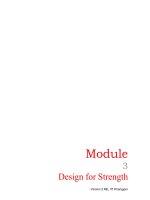Tài liệu Fundamentals of Machine Design P8 doc
Bạn đang xem bản rút gọn của tài liệu. Xem và tải ngay bản đầy đủ của tài liệu tại đây (921.31 KB, 15 trang )
Version 2 ME, IIT Kharagpur
Module
3
Design for Strength
Version 2 ME, IIT Kharagpur
Lesson
2
Stress Concentration
Version 2 ME, IIT Kharagpur
Instructional Objectives
At the end of this lesson, the students should be able to understand
• Stress concentration and the factors responsible.
• Determination of stress concentration factor; experimental and theoretical
methods.
• Fatigue strength reduction factor and notch sensitivity factor.
• Methods of reducing stress concentration.
3.2.1 Introduction
In developing a machine it is impossible to avoid changes in cross-section, holes,
notches, shoulders etc. Some examples are shown in figure- 3.2.1.1.
3.2.1.1F- Some typical illustrations leading to stress concentration.
Any such discontinuity in a member affects the stress distribution in the
neighbourhood and the discontinuity acts as a stress raiser. Consider a plate with
a centrally located hole and the plate is subjected to uniform tensile load at the
ends. Stress distribution at a section A-A passing through the hole and another
BEARING
GEAR
KEY
COLLAR
GRUB SCREW
Version 2 ME, IIT Kharagpur
section BB away from the hole are shown in figure- 3.2.1.2. Stress distribution
away from the hole is uniform but at AA there is a sharp rise in stress in the
vicinity of the hole. Stress concentration factor
t
k
is defined as
3
t
av
k
σ
=
σ
, where
σ
av
at section AA is simply
Ptw b(2)−
and
P
tw
1
σ= . This is the theoretical or
geometric stress concentration factor and the factor is not affected by the
material properties.
3.2.1.2F- Stress concentration due to a central hole in a plate subjected to an
uni-axial loading.
It is possible to predict the stress concentration factors for certain geometric
shapes using theory of elasticity approach. For example, for an elliptical hole in
an infinite plate, subjected to a uniform tensile stress
σ
1
(figure- 3.2.1.3), stress
distribution around the discontinuity is disturbed and at points remote from the
discontinuity the effect is insignificant. According to such an analysis
31
2b
1
a
⎛⎞
σ=σ +
⎜⎟
⎝⎠
If a=b the hole reduces to a circular one and therefore
31
σ =3σ
which gives
t
k
=3.
If, however ‘b’ is large compared to ‘a’ then the stress at the edge of transverse
AA
BB
P
P
σ
2
σ
3
σ
1
t
w
2b
Version 2 ME, IIT Kharagpur
crack is very large and consequently k is also very large. If ‘b’ is small compared
to a then the stress at the edge of a longitudinal crack does not rise and
t
k
=1.
3.2.1.3F
- Stress concentration due to a central elliptical hole in a plate subjected
to a uni-axial loading.
Stress concentration factors may also be obtained using any one of the following
experimental techniques:
1. Strain gage method
2. Photoelasticity method
3. Brittle coating technique
4. Grid method
For more accurate estimation numerical methods like Finite element analysis
may be employed.
Theoretical stress concentration factors for different configurations are available
in handbooks. Some typical plots of theoretical stress concentration factors and
r
d
ratio for a stepped shaft are shown in
figure-3.2.1.4.
σ
1
σ
2
σ
3
2a
2b
Version 2 ME, IIT Kharagpur
3.2.1.4F- Variation of theoretical stress concentration factor with r/d of a stepped
shaft for different values of D/d subjected to uni-axial loading (Ref.[2]).
In design under fatigue loading, stress concentration factor is used in modifying
the values of endurance limit while in design under static loading it simply acts as
stress modifier. This means Actual stress=
t
k
×
calculated stress.
For ductile materials under static loading effect of stress concentration is not very
serious but for brittle materials even for static loading it is important.
It is found that some materials are not very sensitive to the existence of notches
or discontinuity. In such cases it is not necessary to use the full value of
t
k and









